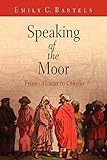Speaking of the Moor : From "Alcazar" to "Othello" / Emily C. Bartels.
Material type: TextPublisher: Philadelphia : University of Pennsylvania Press, [2010]Copyright date: ©2008Description: 1 online resource (264 p.)Content type:
TextPublisher: Philadelphia : University of Pennsylvania Press, [2010]Copyright date: ©2008Description: 1 online resource (264 p.)Content type: - 9780812221015
- 9780812200294
- 822.309355 22
- PR658.A4 B37 2008eb
- online - DeGruyter
- Issued also in print.
| Item type | Current library | Call number | URL | Status | Notes | Barcode | |
|---|---|---|---|---|---|---|---|
 eBook
eBook
|
Biblioteca "Angelicum" Pont. Univ. S.Tommaso d'Aquino Nuvola online | online - DeGruyter (Browse shelf(Opens below)) | Online access | Not for loan (Accesso limitato) | Accesso per gli utenti autorizzati / Access for authorized users | (dgr)9780812200294 |
Frontmatter -- Contents -- Introduction. On Sitting Down To Read Othello Once Again -- Chapter One. Enter Barbary -- Chapter Two. Imperialist Beginnings Hakluyt'S Navigations And The Place And Displacement Of Africa -- Chapter Three. "Incorporate In Rome" -- Chapter Four. Too Many Blackamoors -- Chapter Five. Banishing "All The Moors" -- Chapter Six. Cultural Traffic -- Chapter Seven. The "Stranger Of Here And Everywhere" -- Conclusion. A Brave New World -- Notes -- Bibliography -- Index -- Acknowledgments
restricted access online access with authorization star
http://purl.org/coar/access_right/c_16ec
Selected by Choice magazine as an Outstanding Academic Title"Speak of me as I am," Othello, the Moor of Venice, bids in the play that bears his name. Yet many have found it impossible to speak of his ethnicity with any certainty. What did it mean to be a Moor in the early modern period? In the late sixteenth and early seventeenth centuries, when England was expanding its reach across the globe, the Moor became a central character on the English stage. In The Battle of Alcazar, Titus Andronicus, Lust's Dominion, and Othello, the figure of the Moor took definition from multiple geographies, histories, religions, and skin colors.Rather than casting these variables as obstacles to our-and England's-understanding of the Moor's racial and cultural identity, Emily C. Bartels argues that they are what make the Moor so interesting and important in the face of growing globalization, both in the early modern period and in our own. In Speaking of the Moor, Bartels sets the early modern Moor plays beside contemporaneous texts that embed Moorish figures within England's historical record-Richard Hakluyt's Principal Navigations, Queen Elizabeth's letters proposing the deportation of England's "blackamoors," and John Pory's translation of The History and Description of Africa. Her book uncovers the surprising complexity of England's negotiation and accommodation of difference at the end of the Elizabethan era.
Issued also in print.
Mode of access: Internet via World Wide Web.
In English.
Description based on online resource; title from PDF title page (publisher's Web site, viewed 24. Apr 2022)


